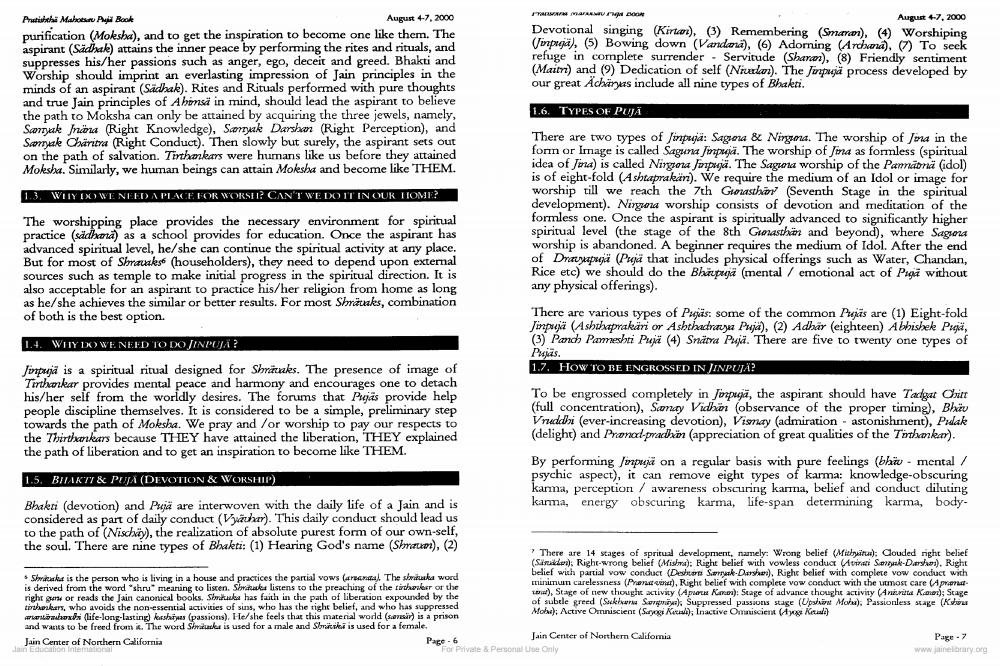Book Title: Puja Book Author(s): Publisher: USA Jain Center Northern Calfornia View full book textPage 4
________________ PAS DOOR August 17, 2000 Devotional singing (Kirtor). (3) Remembering ( Simp), (4) Worshiping (inpega), (5) Bowing down (Vanden). (6) Adoming (Archew), ) To seek refuge in complete surrender. Servitude (Sharp). (8) Friendly sentiment (Mait) and (9) Dedication of self (Nruul). The fupä process developed by our great Achanus include all nine types of Bhakti. Petiichi Mahew All Book Augur 4-7, 2000 purification (Moksha), and to get the inspiration to become one like them. The aspirant (Sidhuck) attains the inner peace by performing the rites and rituals, and suppresses his/her passions such as anger, ego, deceit and greed. Bhakti and Worship should imprint an everlasting impression of Jain principles in the minds of an aspirant (Sachak). Rites and Rituals performed with pure thoughts and true Jain principles of Ahinsa in mind, should lead the aspirant to believe the path to Moksha can only be attained by acquiring the three jewels, namely, Scorrak fina (Right Knowledge), Scorruk Darsha (Right Perception), and Scorrake Charita (Right Conduct). Then slowly but surely, the aspirant sets out on the path of salvation. Tirthakars were hurnars like us before they attained Moksha. Similarly, we human beings can attain Molesha and become like THEM. 1.6. TYPES OF PUJĀ 13. WHY EXWE NEED A PLACE FOR WORSE? CANT WE DO IT IN OUR TIOME? There are two types of Jiuza: Sagrera & Nirgsons. The worship of Join the forn or Image is called Saguna Impia. The worship of fira as formless (spiritual idea of Jina) is called Nirgona mpagi. The Sagen worship of the Pamiri (idol) is of eight-fold (Ashrapraki). We require the medium of an Idol or image for worship till we reach the 7th Glousha (Seventh Stage in the spiritual development). Nirgou worship consists of devotion and meditation of the formless one. Once the aspirant is spiritually advanced to significantly higher spiritual level (the stage of the 8th Growth and beyond), where Sagrera worship is abandoned. A beginner requires the medium of Idol. After the end of Drauga (Pred that includes physical offerings such as Water, Chandan, Rice etc) we should do the Bhaupä (mental / emotional act of Page without any physical offerings). The worshipping place provides the necessary environment for spiritual practice (sädha) as a school provides for education. Once the aspirant has advanced spiritual level, he/she can continue the spiritual activity at any place. But for most of Shmauks (householders), they need to depend upon external sources such as temple to make initial progress in the spiritual direction. It is also acceptable for an aspirant to practice his/her religion from home as long as he/she achieves the similar or better results. For most Shmuskes, combination of both is the best option. 1.4. WHY DO WE NEED TO DO INPOJA? There are various types of Pugas: some of the common Pujās are (1) Eight-fold Jinpjä (Ashraprakiri or Ashthanaya Puja), (2) Adixir (eighteen) Abhishek Pagi, (3) Panch Parti Pupi (4) Snära Pl. There are five to twenty one types of Pacias. 1.7. HOW TO BE ENGROSSED IN JINPUJA? Jopa is a spiritual ritual designed for Shitakes. The presence of image of Tithonkar provides mental peace and harmony and encourages one to detach his/her self from the worldly desires. The forums that Pejas provide help people discipline themselves. It is considered to be a simple, preliminary step towards the path of Moksha. We pray and / or worship to pay our respects to the Thirthakars because THEY have attained the liberation, THEY explained the path of liberation and to get an inspiration to become like THEM. To be engrossed completely in fempeä, the aspirant should have Tadyat Oxime (full concentration), Sanay Vidhin (observance of the proper timing), Bhiu Vnddri (ever-increasing devotion), Visay (admiration. astonishment), Padake (delight) and Pronad-prachin (appreciation of great qualities of the Thakur). 1.5. BITAKTY & PUJA (DEVOTION & WORSHIP) By performing m ga on a regular basis with pure feelings (bhi . mental / psychic aspect), it can remove eight types of karma: knowledge-obscuring karma, perception / awareness obscuring karma, belief and conduct diluting karma, energy obscuring karma, life-span determining karma, body Bhakri (devotion) and Prea are interwoven with the daily life of a Jain and is considered as part of daily conduct (Vacher). This daily conduct should lead us to the path of (Nischay), the realization of absolute purest form of our own-self, the soul. There are nine types of Bhakti: (1) Hearing God's name (Simp), (2) Shatabur is the person who is living in a house and practices the partial vows (acral The s w ord is derived from the word shru meaning to listen. S e listens to the preaching of the taste or the right or reads the Jain canonical books. Sh e has faith in the path of liberation expounded by the chester, who avoids che non-essencial activities of sins, who has the right belief, and who has suppressed a nd life-long-lasting) kushin (passions). He/she feels that this maternal word (s ) is a prison and was to be freed from . The word S uur is used for a male and is used for a female. Jain Center of Northern California Page - 6 For There are 14 stages of spritual development, namely: Wrong belief (Mi ): Couded right belief (Sard Righe wrong belief (Mis ): Right belief with vowless conduct a Sea-Darsh). Right belief with partial vow conduct Descon S u -Darshes). Right belief with complete vow conduct with muninun carelessness (Pan ), Right belief with complete wow conduct with the most care prin w), Stage of new thought activity (Aperta kemas: Seage of advance thought activity (Ana Ko : Stage of subtle greed (Sukhane Sur Suppressed passions stage (Upin Mohs)Passionless stage (Kw Alok). Active Omniscient ( S es Katult). Inactive Omniscienty Ku) Jain Center of Northern California Persone l Page 7Page Navigation
1 2 3 4 5 6 7 8 9 10 11
